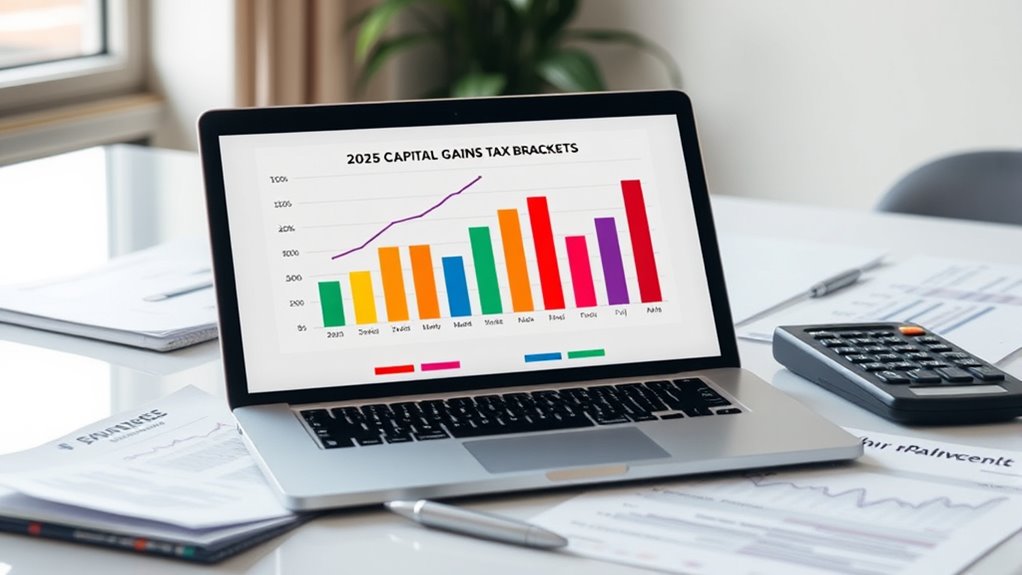In 2025, capital gains tax brackets remain similar to previous years, with rates depending on your income level and how long you’ve held assets. If your income is lower, you might pay 0% on long-term gains, while higher earners could face rates up to 20%. Strategizing asset sales and leveraging loss harvesting can help you maximize benefits and reduce taxes. Keep exploring to discover proven tactics for efficient tax management and wealth preservation.
Key Takeaways
- Capital gains tax brackets in 2025 will likely be similar to current thresholds with inflation adjustments.
- Income levels determine whether long-term gains are taxed at 0%, 15%, or 20%.
- Strategies include timing asset sales, loss harvesting, and gifting to optimize tax rates.
- Understanding the “step-up” basis in estate planning can minimize future capital gains taxes.
- Staying informed on legislative changes helps adapt strategies to maximize tax advantages in 2025.

Understanding capital gains tax brackets is essential for anyone looking to maximize their investment returns. Knowing how different income levels influence your tax rate can help you plan your investments more effectively, especially when considering strategies like estate planning and tax loss harvesting. Capital gains taxes are structured into brackets, which means that the rate you pay depends on your taxable income and the type of asset you sell. Long-term capital gains, which are taxed at lower rates than short-term gains, are taxed at lower rates than short-term gains, which are taxed as ordinary income. In 2025, these brackets are likely to remain similar but could adjust slightly for inflation, so staying updated is key. Being aware of your current bracket can influence whether you sell appreciated assets now or wait until a more favorable tax period. Additionally, strategic gifting or setting up trusts can help manage capital gains exposure, aligning with your overall estate goals. If your income is below certain thresholds, you might pay 0% on long-term capital gains, making it advantageous to hold onto assets until you qualify for this lower rate. As your income increases, you’ll move into higher brackets, paying 15% or, in some cases, 20%. Understanding where you fall allows you to time your sales strategically. For example, if you’re close to a threshold, you might choose to delay a sale or accelerate it to optimize your tax outcome. This is where tax loss harvesting comes into play. By intentionally selling investments at a loss, you can offset gains from other investments, reducing your overall tax liability. This tactic is especially useful in volatile markets and can be integrated into your estate planning to preserve wealth across generations. Estate planning benefits markedly from a clear grasp of capital gains tax brackets. When you transfer assets to heirs, they often inherit a “step-up” in basis, which can minimize capital gains taxes on future sales. However, proactive planning, including the timing of asset sales and harvesting losses, ensures you optimize your tax position now and for your beneficiaries. Being aware of your current bracket can influence whether you sell appreciated assets now or wait until a more favorable tax period. Additionally, strategic gifting or setting up trusts can help manage capital gains exposure, aligning with your overall estate goals. Furthermore, understanding the emerging tax policies can help you adapt your strategies proactively in response to legislative changes.
Frequently Asked Questions
How Will Upcoming Tax Reforms Impact Capital Gains Rates?
Upcoming tax reforms are likely to increase capital gains rates, affecting your investment returns. You should consider tax reform implications now and adjust your investment strategy accordingly. This might include timing asset sales or exploring tax-efficient investment options. Staying informed about proposed changes helps you minimize tax impacts and optimize gains. Regularly consulting a financial advisor ensures your strategy aligns with evolving regulations, helping you safeguard your wealth effectively.
Are There Specific Strategies for High-Net-Worth Individuals?
You can unlock extraordinary savings by leveraging estate planning and charitable giving strategies. High-net-worth individuals often use gifting to reduce taxable gains, avoiding hefty taxes on investments. Establishing trusts or donating appreciated assets can dramatically lower your tax burden and grow your wealth faster than you imagined. Don’t miss out on these powerful tactics—strategically planning your estate and charitable contributions can transform your financial future into an unstoppable wealth-building machine.
How Do State Taxes Affect Overall Capital Gains Liability?
State taxes substantially impact your overall capital gains liability through varying state tax implications and local tax considerations. Some states levy high taxes on gains, increasing your total tax burden, while others have no capital gains tax at all. You need to evaluate your state’s policies and consider strategies like timing sales or relocating to reduce these local tax considerations, ultimately maximizing your after-tax gains.
What Are the Best Tax-Advantaged Investment Options?
Did you know that over 60% of successful investors use tax-advantaged accounts? To maximize your gains, consider Tax Deferred Accounts like IRAs and 401(k)s, which let your investments grow tax-free or tax-deferred. Diversify your portfolio across asset classes to reduce risk and improve returns. These strategies help you keep more of your investment profits and build wealth efficiently over time.
Can Losses Be Carried Forward to Offset Gains?
Yes, you can carry forward losses to offset future gains. When you engage in loss harvesting, you sell investments at a loss to reduce your tax bill, and if your losses exceed gains, you can defer the remaining losses through deferred sales. This strategy helps you manage your tax liability over multiple years, allowing you to offset gains later and maximize your investment efficiency.
Conclusion
Did you know that nearly 60% of investors pay long-term capital gains taxes? As you plan for 2025, understanding the new tax brackets can help you maximize your investments and minimize taxes. By strategically holding onto assets or timing your sales, you could save thousands. Stay informed and consider consulting a financial advisor to make the most of these changes. Don’t let taxes catch you off guard—stay ahead and keep more of your hard-earned money.








